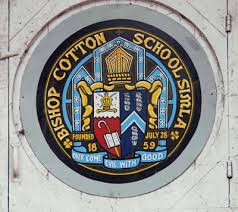Admission Open for 2019 - Bishop Cotton School, Shimla, Himachal Pradesh | Boarding at Bishop Cotton School, Shimla
Study at Bishop Cotton School, Shimla, Himachal Pradesh, it is considered as the Best Residential Schools in Shimla. Contact BoardingEdu to know more about Admission Process, Academic Fees, Curriculum, School Overview and other facilities of Bishop Cotton School, Shimla, Himachal Pradesh
Bishop Cotton, in a letter written to Dr. Slater had suggested the School Motto: "Overcome Evil with Good". He wrote: I have suggested 'Overcome Evil with Good' as the motto for the School. It was the text on which I preached in the Cathedral in Calcutta on the Thanksgiving Day in 1859 when the School may be considered to have been founded. The idea of the 'Public School', which carries so clear an image today, did not exist in 1859 in India and the history of Bishop Cotton School is of public interest for the part it played in the development of public schools and in the wider history of education in this country.
In the 1840′s the great schools numbered not more than half a dozen in England, and Eton, the largest, catered for fewer than 500 boys. In India, there were a handful of private schools and Military Asylums, educating the children of their neighborhood rather than the public at large. Bishop Cotton School, Shimla, is the one of the oldest boarding schools in Asia, having been founded on 28th July, 1859, by Bishop George Edward Lynch Cotton, son of an Army Captain, who died leading his Regiment in battle. A scholar of Westminster, and a graduate of Cambridge, in 1836 he was appointed Assistant Master at Rugby by Doctor Thomas Arnold, one of the founders of the British Public School system. It was the young Mr. Cotton who is spoken of as the “the model young master” in Thomas Hughes’ famous book “Tom Brown’s School Days” which gives an insight to school life at Rugby.
After having taught for 15 years at Rugby, in 1852, he was appointed Master of Marlborough, where he established organized games and the House and prefect systems. He believed that ” the prefects are and shall be, long as I am the Head, the governors of the school. As soon as I see this impracticable I will resign…..” He was consecrated Bishop at Westminster Abbey by the Archbishop of Canterbury. Queen Victoria personally selected Bishop Cotton as Bishop of Calcutta and Metropolitan Bishop of India, Burma and the Island of Ceylon, keeping in view the critical period in India around 1857.
As Bishop of Calcutta, on 28TH July, 1859, he conducted a service for the foundation of a public school at a hill station. Collections were made. in most of the Churches of the Diocese for this purpose. The collections were utilized to found the Bishop’s School at Jutogh, Shimla. The land and the buildings on it were a gift from the Viceroy. Three private houses were purchased by Bishop Cotton out of the India Public School Fund for Rs.17,000/- The school opened for students on 15th March, 1863. Though mentioned in correspondence as the Simla Public School, it never actually bore this name. The first boy, Frederick Naylor, joined the school on 16th March, 1863, “creeping like a snail, unwilling to school,” watched by the staff in curiosity and amusement. 35 boys were admitted that year and the school increased its strength to 65 students by the year 1864. This was the highest number the buildings and grounds permitted. A change of site was then deemed necessary because the Jutogh site was divided by a public road which was inconvenient. Bishop Cotton personally reconnoitered ten sites in September and October 1864, and finally approved the South end of Knollswood Spur which belonged to the Rajah of Keonthal. After lengthy negotiations the site was acquired through the intervention of the Viceroy and the foundation stone for the new buildings was laid on 26th September 1866, by H.E. the Viceroy, Sir John Lawrence, elder brother of Sir Henry Lawrence, founder of the Military Asylum at Sanawar (now known as Lawrence School). In September 1868, the school moved to Knollswood, our present site.
Mission Statement :
“Bishop Cotton School strives to achieve and maintain the highest standard of excellence in its programme of total education empowering men rooted in India’s heritage to live as committed and good human beings contributing positively to the country.”
Headmaster - R. C. Robinson
Admission Open for 2019 -2020 Session - Bishop Cotton School, Shimla, Himachal Pradesh
Facilities
Campus:
- Curzon House
- Ibbetson House
- Lefroy House
- Rivaz House
- Classroom Shots
- Labs
- Library
- Art Gallery
- Dining Area & Kitchen
- Infirmary
- Play Grounds
- Shooting Range
- Internet Browsing Center
- Chipu’s (School Canteen)
- Daily Schedule
- Safety And Security
The Main School Building :The school buildings were erected entirely by donations. The school was built in Gothic architecture on a plan furnished by Crawford Cambell and erected by Major Innes. It was occupied in September 1868. Unfortunately on Sunday evening the seventh of May, 1905, whilst most of the boys were on "Khud Leave", the school caught fire. The fire as far as can be traced originated from an oil stove owned by the master living in the right wing of the building. The complete school was burnt except the H.M.’s Lodge, Senior Master’s house and the hospital. The school was rebuilt, generally on the same architecture and occupied in July 1907. On the first floor of the building are the four house divided into dormitories. The class rooms are on the ground floor. It was in 1906 that the dormitories were changed to houses. One house was named after Lord Curzon, Viscount George Nathanial, Viceroy of India 1898-1905, with the Latin motto "Facto Non Verba" (Facts not words). House colour adopted was Red. The second house was named after Lefroy, Rt. Rev. Bishop of Lahore 1899-1901, with the motto "SpernoMutare" (I scorn to change). The house colour adopted was Green. The third house was named after Ibbetson, Sir Denzil, Governor of Punjab 1906-1908 with the motto "NecImpetuNecImperio" (Neither by force nor by command) with the house colour Oxford Blue. The last house was named after Rivaz, Sir Charles, Governor of Punjab 1903-1906, with the motto of "Servamus" (We Serve). The house colour adopted was Cambridge Blue. All the house names, mottos and colours were chosen by Mr. G.S. Stokes, Senior Assistant Master 1906.
Irwin Hall :This spacious and dignified hall is used for all school functions, lectures, theatricals, debates and cinema shows. The walls are adorned with numerous honours boards and portraits of past Headmasters for over one fifty years. The stage is equipped with mechanical and electrical apparatus, and there is a pit for the orchestra. The portrait of the founder Bishop Cotton was painted by Mr. Eddis in 1852 which hangs in the Arnold Library at Rugby. Mr. Eddis consented to accept the subscription raised by the boys amounting to Rs.720/- to paint a modified copy of this former portrait. It was unveiled in 1869 and adorns the walls of Irwin Hall.
The Irwin Hall is named after HE Rt. Hon. E F L Wood, GMSI, GMIE, Baron Irwin of Kirby and Enderdale in the County of York, Viceroy and Governor General of India, who inaugurated the Hall on 20th September 1930.
During the tumultuous partition days, on 22nd October 1947, the Headmaster addressed 42 Pakistani Muslim boys in the Irwin hall in the presence of the School and the Staff. After his address, the middle door of the hall, through which, according to an old tradition, only Viceroys and Presidents enter and school Captains leave the school, was flung open by two prefects and Hasan Agha, the School Captain walked out, not among the cheers of his fellow students, as previous School Captains had done, but in deep and sorrowful silence.
In 2009, the middle door was opened by Mr. Humyum Khan, former ambassador of Pakistan to India, Old Cottonian. Mr. Khan led the Pakistani Muslim boys returned to their alma mater to celebrate the Sesquicentennial Celebrations of the School.
Program


![]() Shimla, Himachal Pradesh, India
Shimla, Himachal Pradesh, India

